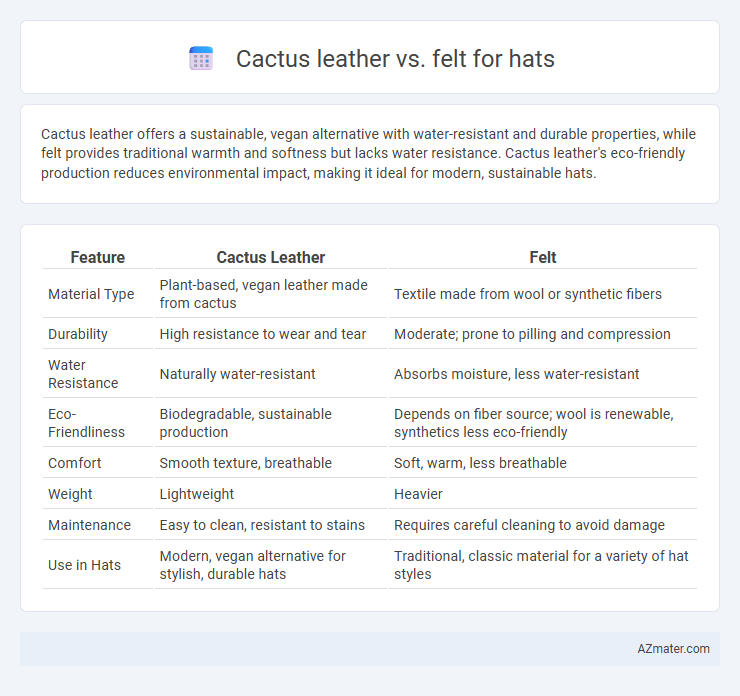Cactus leather offers a sustainable, vegan alternative with water-resistant and durable properties, while felt provides traditional warmth and softness but lacks water resistance. Cactus leather's eco-friendly production reduces environmental impact, making it ideal for modern, sustainable hats.
Table of Comparison
| Feature | Cactus Leather | Felt |
|---|---|---|
| Material Type | Plant-based, vegan leather made from cactus | Textile made from wool or synthetic fibers |
| Durability | High resistance to wear and tear | Moderate; prone to pilling and compression |
| Water Resistance | Naturally water-resistant | Absorbs moisture, less water-resistant |
| Eco-Friendliness | Biodegradable, sustainable production | Depends on fiber source; wool is renewable, synthetics less eco-friendly |
| Comfort | Smooth texture, breathable | Soft, warm, less breathable |
| Weight | Lightweight | Heavier |
| Maintenance | Easy to clean, resistant to stains | Requires careful cleaning to avoid damage |
| Use in Hats | Modern, vegan alternative for stylish, durable hats | Traditional, classic material for a variety of hat styles |
Introduction to Sustainable Hat Materials
Cactus leather, made from mature cactus leaves, offers a durable and eco-friendly alternative to traditional hat materials by minimizing water usage and avoiding harmful chemicals. Felt, often crafted from natural wool fibers, provides excellent insulation and breathability while being biodegradable and renewable. Both materials contribute to sustainable fashion by reducing environmental impact and promoting cruelty-free production methods.
What is Cactus Leather?
Cactus leather is an innovative, sustainable material made from mature leaves of the nopal cactus, processed into a durable, eco-friendly alternative to traditional leather. Unlike felt, which is a textile produced by matting and pressing fibers such as wool, cactus leather offers a vegan option with a texture and flexibility similar to animal leather. Its water resistance and breathability make it ideal for hat production, combining style with environmental responsibility.
What is Felt?
Felt is a non-woven textile produced by matting and compressing natural fibers such as wool or synthetic materials, creating a dense fabric favored for hat making due to its durability and ability to hold shape. Unlike cactus leather, a sustainable plant-based alternative derived from the mature leaves of the nopal cactus, felt offers excellent insulation and water resistance, making it ideal for traditional hats like fedoras and bowlers. The choice between cactus leather and felt depends on priorities such as eco-friendliness, texture, and intended use, with felt known for its timeless appeal and cactus leather noted for innovation in sustainable fashion.
Environmental Impact: Cactus Leather vs Felt
Cactus leather is a sustainable alternative to traditional materials, made from mature cactus leaves that require minimal water and no harmful chemicals, significantly reducing environmental impact compared to felt, which is often produced from wool or synthetic fibers with higher water consumption and carbon emissions. Felt production typically involves energy-intensive processes and may use chemicals for felting, contributing to pollution and resource depletion. Choosing cactus leather supports eco-friendly fashion by minimizing water use and chemical waste, aligning with sustainable manufacturing practices.
Durability and Longevity Comparison
Cactus leather offers exceptional durability with its natural resistance to water and wear, often outperforming traditional felt in maintaining shape and texture over time. Felt hats, typically made from wool or synthetic fibers, provide moderate durability but are prone to moisture damage and compression, reducing their lifespan. Choosing cactus leather ensures a longer-lasting, eco-friendly hat that withstands daily use while retaining aesthetics and structural integrity.
Comfort and Wearability
Cactus leather offers a lightweight, breathable alternative that enhances comfort by allowing better air circulation compared to felt's denser construction. Felt hats provide superior insulation and a soft, flexible fit that molds to the head over time, improving wearability in colder climates. Choosing between cactus leather and felt depends on desired temperature regulation and the balance of durability versus softness.
Style and Aesthetic Differences
Cactus leather offers a sleek, modern appearance with a smooth, uniform texture that enhances contemporary hat designs, while felt provides a classic, matte finish with a soft, tactile feel ideal for traditional or vintage styles. Cactus leather's slight sheen and environmentally friendly appeal make it a trendy choice for fashion-forward consumers seeking sustainability. Felt's versatility allows for varied thickness and structure, lending hats a timeless elegance that complements formal and casual wear alike.
Price and Availability
Cactus leather offers a premium, eco-friendly alternative to traditional felt, typically priced higher due to sustainable production processes and limited suppliers. Felt remains widely available and more affordable, benefiting from mass production and established supply chains. Consumers seeking cost-effective options will find felt hats more accessible, while cactus leather appeals to those prioritizing sustainability despite the price premium.
Maintenance and Care
Cactus leather requires minimal maintenance, needing only occasional wiping with a damp cloth and avoiding direct sunlight to prevent fading and cracking. Felt hats demand more careful handling, including regular brushing to remove dust and the use of specialized cleaning products to maintain shape and texture. Both materials benefit from proper storage in a cool, dry place to extend the lifespan and preserve appearance.
Which Material is Best for Your Hat?
Cactus leather offers a sustainable, cruelty-free alternative with durability and water resistance, making it ideal for long-lasting, weather-proof hats. Felt, traditionally made from wool or synthetic fibers, provides excellent insulation, breathability, and a classic aesthetic preferred for formal or vintage-style hats. The best material depends on whether you prioritize eco-friendliness and resilience (cactus leather) or comfort and timeless style (felt).

Infographic: Cactus leather vs Felt for Hat
 azmater.com
azmater.com